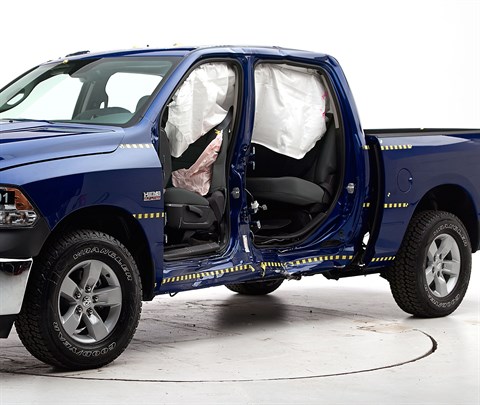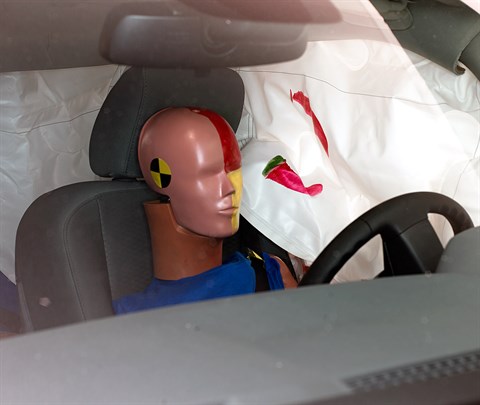Moderate overlap front: original test
Rating applies to 2013-18 models
Tested vehicle: 2009 Dodge Ram 1500 ST Crew Cab 2wd
The Dodge Ram 1500 Crew Cab was redesigned for the 2009 model year. Frontal ratings are assigned by the Institute based on a test conducted by Chrysler. The make name "Dodge" was officially changed to "Ram" beginning with the 2013 model year.
| Evaluation criteria | Rating |
|---|---|
| Overall evaluation | |
| Structure and safety cage | |
| Driver injury measures | |
| Head/neck | |
| Chest | |
| Leg/foot, left | |
| Leg/foot, right | |
| Driver restraints and dummy kinematics | |
Side: original test
Rating applies to 2013-18 models
Tested vehicle: 2016 Ram 1500 ST Crew Cab 2wd
The Dodge Ram 1500 Crew Cab was redesigned for the 2009 model year. Beginning with 2009 models manufactured after September 2008, the front door trim panels were modified to improve occupant protection in side impact crashes.
Beginning with 2012 models manufactured after January 2012, side airbags designed to protect drivers' and front passengers' torsos were added to the side curtain airbags previously included. (Information about when a specific vehicle was manufactured is on the certification label typically affixed to the car on the driver door or adjacent B-pillar.)
The make name "Dodge" was officially changed to "Ram" beginning with the 2013 model year.
| Evaluation criteria | Rating |
|---|---|
| Overall evaluation | |
| Structure and safety cage | |
| Driver injury measures | |
| Head/neck | |
| Torso | |
| Pelvis/leg | |
| Driver head protection | |
| Rear passenger injury measures | |
| Head/neck | |
| Torso | |
| Pelvis/leg | |
| Rear passenger head protection The side curtain airbag deployed on the wrong side of the dummy's head, before the head had begun to move outward toward the rear passenger door. As a result, the head was hit by the pillar behind the door. This pillar is required by federal standard to provide some protection for occupants' heads. (The window glass, which remained intact during the crash, and the unpadded steel window frame were pulled away from the occupant compartment and did not hit the dummy's head.) | |

View of the vehicle and barrier just after the crash test.

View of the vehicle after the crash with doors removed, showing the side airbags and damage to the occupant compartment.

Smeared greasepaint shows where the driver dummy's head was protected from being hit by hard structures by the side curtain airbag.

The side curtain airbag deployed on the wrong side of the rear passenger dummy's head, and smeared greasepaint shows where the head was hit by the dislodged roof trim. The head was also hit by the pillar behind the rear door.
Roof strength
Rating applies to 2013-18 models
Tested vehicle: 2011 Dodge Ram 1500 ST Crew Cab 2wd
| Overall evaluation | |
|---|---|
| Curb weight | 5,186 lbs |
| Peak force | 15,412 lbs |
| Strength-to-weight ratio | 2.97 |
Head restraints & seats
Seat type: Power cloth seats
| Overall evaluation | |
|---|---|
| Dynamic rating | |
| Seat/head restraint geometry |
About the head restraint & seat test
Currently, IIHS tests apply only to front seats.